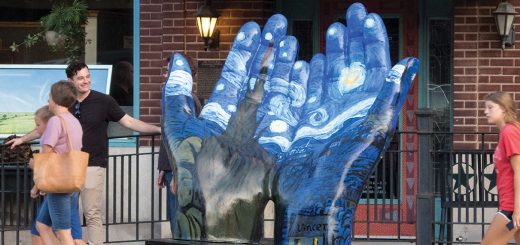Restoring Pollinators

by Julie Nichols
Pollinators don’t just make flowers bloom. Over 150 crops in the U.S. require pollination for seed or food production. Most pollination is accomplished through the services of a wide variety of creatures. One out of three bites of food can be attributed to these important creatures—many species of bees, butterflies, moths, birds, beetles,
Recently, much attention has been paid to an alarming decline of pollinators. Many studies indicate decreasing populations throughout the U.S. The causes of this decline can be attributed to habitat loss, disease, parasites, poor nutrition and improper pesticide use.
Concern over falling populations of pollinators has sparked local programs that address their disappearance. Lincoln has wholeheartedly taken the challenge through offering a variety of ways ordinary citizens can support and provide pollinator habitats.
Fortunately, cooperation between several local organizations has brought both education and installation of pollinator plants to the fore. The Nebraska State Arboretum and the University of Nebraska Department of Entomology and the Nebraska Environmental Trust (NET) have partnered to provide resources and instruction to the public.
The Bloom Box program was created with two goals in mind: to increase physical pollinator habitat in communities and to educate the public about the crucial need to help bolster a declining pollinator population and what people can do to help.
Each type of Bloom Box comes with a sign to identify to neighbors and passersby that a homeowner or school is building and nurturing pollinator habitats. A crucial part of growing and maintaining this habitat is protection from chemicals. The sign also starts conversations about pollinators, the challenges they face and why they are so vital.
The Million Pollinator Garden Challenge, an initiative of the Pollinator Partnership pursues the same goal: to encourage the planting and increase of habitat. In order to gauge the success of the program as well as providing research about the amount of habitat, The Pollinator Partnership manages a website that maps every pollinator garden reported to them. Participants in the program are asked to register their gardens and display the signs to contribute to these efforts.
A standard Bloom Box welcomes bees and butterflies with a 100 square foot garden of 24 plants customized for the buyer, or a homeowner can start small with a Bloom Box Mini, with a dozen hand-selected plants. Pollinator gardens can be enhanced with a Weed Shield plant pack—36 ground cover or low-growing plants that diminish weeds. The Bloom Box @ School gets students involved in learning about plants and pollinators with 100 square foot garden of 24 plants, geared for outdoor classrooms, which are being added each year to elementary and middle schools. The costs are minimal. For between $54 and $144, Lincoln schools and individuals can increase the viable habitat for pollinator feeding and reproduction.
Helping pollinators can be as simple as selecting high-quality pollinator plants for your garden and region. But the producers of our crops—farmers and ranchers—can also support and increase pollinator habitat.
Through a program administered through the USDA, Nebraska farmers can also expand pollinator habitat. Pollinator populations can be increased by planting wildflowers in and around fields, in grass belts along access roads and selecting the right cover crops. Habitats used by pollinators attract insects beneficial to crops (insects that eat pests); they also provide habitat for other wildlife, reduce soil erosion, and improve water quality. Pollinators and a robust, healthy habitat help keep the ecosystem thriving. Learn more about how farmers and ranchers are doing their part to aid pollinators at www.nrcs.usda.gov/pollinators. Lately, focus has been placed on monarch populations under threat, although worldwide research has been conducted for decades. In addition to many habitat restoration projects, Nebraska Game and Parks is studying the number and distribution of monarchs in the state in order to target areas that provide suitable habitat.
Lincoln’s increasing number of neighborhood gardens also provides food and habitat for pollinators during the growing season; indeed, they depend upon them. The Sunken Garden and the Rose Garden on 27th Street provide food for insects all summer. However, some large parks on the perimeter of the city have long done their part to support habitat.
Pioneers Park Nature Center, a 668-acre park, offers visitors accessible tallgrass prairie, woodlands and wetlands, and eight miles of hiking trails that wind through various habitats where non-releasable raptors, bison, elk and
Its 850-acre tallgrass prairie preserve, two-thirds virgin grassland (never plowed) offers miles of walking trails that pass through wildflowers and grasses, ponds and wetlands, historic wagon ruts, and serene views. A myriad of birds and other wildlife occupy this serene and natural park gives visitors a taste of what Nebraska looked like before settlement. Education programs are offered year round.
Spring Creek is open all week in all seasons with the exception of major holidays. The visitors’ center operates 9-5 weekdays, and 1-5 on weekends. Trails are open from sunrise to sunset. Admission is $4 for adults; $3 for children, students and seniors. Admission is free on Tuesdays.
At 1,472 acres and most of it public, Wilderness Park is Lincoln’s largest, located to the southwest. Separated into several branches, the park is heavily wooded. Beal Slough—a tributary of Salt Creek—winds through the park, where foxes, deer, raccoons, opossums, frogs, hawks, owls and songbirds reside. A walk or ride through the park gives visitors a variety of habitat, a getaway from the city, and a cool escape during summer months. Wilderness Park features a vast network of walking trails, bike and horse trails. The park is accessible in all seasons.
Launched over the last several years, the Southern Heights Food Forest is the first of its kind in the nation. Also in South Lincoln near the Southern Heights Presbyterian Church, this eclectic project includes an outdoor classroom, over 50 community gardens, an urban agriculture area and a cultivated food forest, all on two acres. Built to catalyze community development, the Food Forest is used as a Nature Explore Outdoor Classroom, where children can play safely while learning the value of local food and community, and can have direct contact with the earth.
As Lincoln continues to grow, natural spaces set aside for the public show a commitment to the natural world and gives residents direct contact with creatures and plants that reside nearby.
To find the best plants for your area, visit the websites of NRCS partners at the Xerces Society Pollinator Conservation Program.
Who We Are
The Southern Heights Food Forest is the first of its kind in the nation. The 2-acre space in South Lincoln includes a full-sized, research-based outdoor classroom, over 50 community gardens, an urban agriculture plot, and Nebraska’s first food forest.
What We Do
Our vision is to change the way we think about and value public space as a community. Creating a space where entire communities and families come together to interact with each other and build relationships. A space where children can play freely while learning about nature, where we teach each other about food, where people form multi-generational relationships—a catalyst for true community development.














Recent Comments